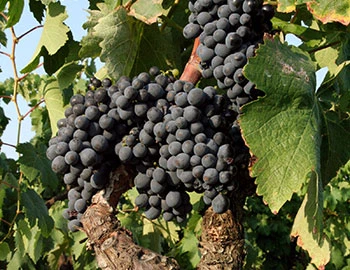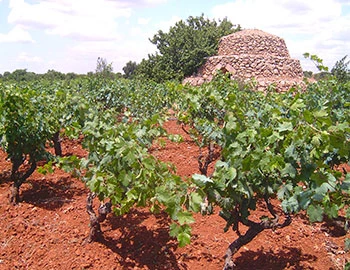168 Dalian - Primitivo Cuvée 2020
IGT Taranto Apulien, Principe di San Martino, 750 ml

| Grape variety: | Primitivo, Negroamaro, Malvasia |
| Producer: | Principe di San Martino |
| Origin: | Italy / Puglia |
Description
Pleasant nose of wild berries, plum and vanilla with floral notes of violets. On palate roundness and silkiness characterise this elegant wine. Full of life, the finish remains fresh and smooth.
Attributes
| Origin: | Italy / Puglia |
| Grape variety: | Primitivo, Negroamaro, Malvasia |
| Label: | Vegan |
| Ripening potential: | 2 to 3 years |
| Drinking temperature: | 16 to 18 °C |
| Food Pairing: | Spiced grillades, Spaghetti alla bolognese, Spaghetti carbonara, Orecchiette, Strozzapreti alla siciliana, Pizza or Flammkuchen |
| Vinification: | fully destemmed, long must fermentation |
| Maturation: | in steel tank |
| Maturation duration: | 9 months |
| Volume: | 13.0 % |
| Note: | Contains sulphites |
Principe di San Martino
Malvasia
A hint of smoke
Lively citrus aromas and a touch of smoke are the hallmarks of the southern French Bourboulenc. It is also known as Clairette blanche or Malvoisie. This white wine grape is almost never produced solo. Instead, it lends its freshness to the white Châteauneuf-du-Pape and many other assemblages in southern France. Its origins lie in the Vaucluse Plateau in Provence. It turns out particularly delightfully in the massif of La Clapa in Languedoc, directly on the Mediterranean. There, the wines from Malvoisie acquire a salty-iodine note.

Primitivo
The perfect pizza wine
Primitivo is by no means primitive. The name comes from the Latin "primativus", which means “the first to ripen”. Thus a botanist named the grapes when he discovered them in 1799 in southern Italy. Their stronghold is in Apulia, but they originally came from Croatia, where they are known as Tribidrag. The Greek word means exactly the same thing: early ripening. With its exuberant berry fruit, spice and exciting fresh acidity, the Primitivo is the perfect pizza wine. Incidentally, Californians also drink Zinfandel with their pizza. This is a synonym for an identical grape, even if there are vintners on both sides of the ocean who do not want to admit it...

Negroamaro
Velvety southern Italian
Translated, Negroamaro means “black and bitter”. But the deep, dark wines from this grape are not at all bitter. On the contrary, fans of soft, lush reds appreciate it for of its pronounced sweetness, its bouquet of ripe dark fruit and for its velvety tannins. The Negroamaro is at home in Apulia, the heel of the Italian boot. It is known under numerous synonyms, an indication that it is an old, native variety. The best examples come from old vines grown in bush form near the cooling sea. Tip: do not let wines from Negroamaro sit too long in the cellar. They have limited aging potential. It is best to drink them when they are young. They are perfect for spaghetti alla puttanesca.

Puglia
Apulien: Frischer Wind aus dem Süden
Kaum eine Weinregion in Italien konnte ihr Qualitätsniveau in den letzten zehn Jahren so stark steigern, wie Apulien. Noch vor wenigen Jahren waren die rund 100‘000 Hektar, auf denen hier Wein produziert wird, ein Reservoir für anspruchslose Massenweine. Vor allem der einst kantige, alkoholreiche und trotzdem oft restsüsse Primitivo hat seinen Charakter völlig geändert. Dank neuem Know How in Rebberg und Keller, zeigen die Primitivo-Weine nun jene mediterrane Opulenz und würzige Fruchtfülle, welche die Weinliebhaber im Norden ausserordentlich schätzen.

Italy
Italy – Where wine is a way of life
The Italian wine regions are extremely diverse, and this is made clear in their wines. Established varieties such as Merlot, Syrah, and Sauvignon can be found on just 15 percent of the total vine growing area. The remaining 85 percent is reserved for autochthonous, indigenous varieties. More than 2,000 different grape varieties are grown under diverse conditions and pressed with various techniques into wines that reach the top tier of the international wine market.




